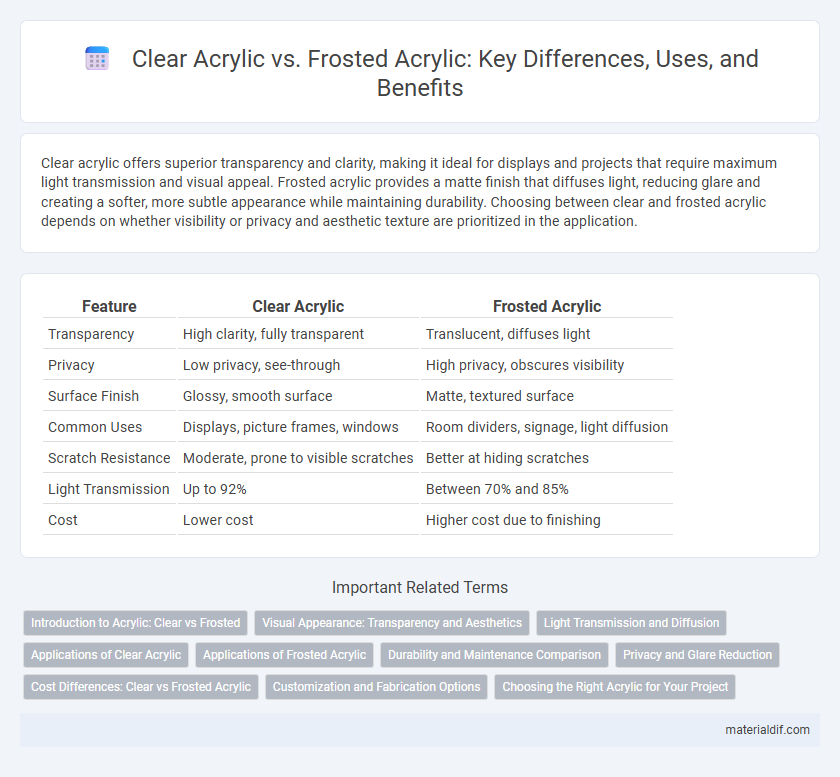Clear acrylic offers superior transparency and clarity, making it ideal for displays and projects that require maximum light transmission and visual appeal. Frosted acrylic provides a matte finish that diffuses light, reducing glare and creating a softer, more subtle appearance while maintaining durability. Choosing between clear and frosted acrylic depends on whether visibility or privacy and aesthetic texture are prioritized in the application.
Table of Comparison
| Feature | Clear Acrylic | Frosted Acrylic |
|---|---|---|
| Transparency | High clarity, fully transparent | Translucent, diffuses light |
| Privacy | Low privacy, see-through | High privacy, obscures visibility |
| Surface Finish | Glossy, smooth surface | Matte, textured surface |
| Common Uses | Displays, picture frames, windows | Room dividers, signage, light diffusion |
| Scratch Resistance | Moderate, prone to visible scratches | Better at hiding scratches |
| Light Transmission | Up to 92% | Between 70% and 85% |
| Cost | Lower cost | Higher cost due to finishing |
Introduction to Acrylic: Clear vs Frosted
Clear acrylic offers high transparency and excellent light transmission, making it ideal for applications requiring maximum visibility and clarity. Frosted acrylic features a textured, matte surface that diffuses light and reduces glare, providing privacy while maintaining a modern aesthetic. Both types are lightweight, impact-resistant, and versatile for signage, displays, and architectural elements.
Visual Appearance: Transparency and Aesthetics
Clear acrylic offers exceptional transparency with up to 92% light transmission, making it ideal for applications requiring maximum visibility and a glass-like, glossy finish. Frosted acrylic diffuses light, reducing glare and obscuring visibility while providing a matte, textured surface that enhances privacy and adds a sophisticated, contemporary aesthetic. Both materials are durable and lightweight, but the choice between clear and frosted acrylic primarily depends on the desired visual effect and degree of translucency.
Light Transmission and Diffusion
Clear acrylic offers superior light transmission, allowing up to 92% of visible light to pass through with minimal scattering, making it ideal for applications requiring maximum clarity and brightness. Frosted acrylic diffuses light evenly by scattering it, which reduces glare and softens shadows, creating a more uniform illumination while transmitting around 80-85% of light. The choice between clear and frosted acrylic depends on the need for either high transparency or diffused lighting effects in design and architectural projects.
Applications of Clear Acrylic
Clear acrylic offers exceptional optical clarity and high light transmittance, making it ideal for applications such as display cases, retail signage, and protective barriers. Its smooth, glossy surface enhances visual presentation and is commonly used in aquariums, picture frames, and windows where transparency is crucial. Clear acrylic's durability and weather resistance also suit outdoor signage and architectural glazing, providing both aesthetic appeal and structural integrity.
Applications of Frosted Acrylic
Frosted acrylic is widely used in applications requiring diffused light and privacy, such as office partitions, signage, and decorative panels. Its translucent surface softens harsh lighting, making it ideal for backlit displays and lightboxes in retail and exhibition settings. Additionally, frosted acrylic's scratch-resistant and non-glare properties enhance its functionality in architectural glazing and protective screens.
Durability and Maintenance Comparison
Clear acrylic offers superior transparency and is highly resistant to impact and weathering, making it ideal for applications requiring maximum clarity and durability. Frosted acrylic, while slightly less transparent, provides excellent scratch resistance and hides fingerprints and smudges better, reducing the frequency of cleaning. Both materials are low-maintenance, but clear acrylic may require more regular cleaning to maintain its pristine appearance due to its tendency to show dirt and scratches more prominently.
Privacy and Glare Reduction
Clear acrylic offers high transparency, ideal for applications requiring maximum visibility but provides minimal privacy and glare reduction. Frosted acrylic diffuses light, significantly enhancing privacy by obscuring detailed views while also reducing glare, making it suitable for environments where light management and discretion are priorities. Selecting frosted acrylic improves comfort and privacy without sacrificing the durability and versatility inherent to acrylic materials.
Cost Differences: Clear vs Frosted Acrylic
Clear acrylic generally costs less than frosted acrylic due to simpler manufacturing processes and higher demand. Frosted acrylic involves an additional surface treatment that increases production time and expenses, leading to higher prices. Businesses should weigh these cost differences against aesthetic and functional needs when selecting between clear and frosted acrylic.
Customization and Fabrication Options
Clear acrylic offers exceptional transparency and can be easily customized through laser cutting, engraving, and thermoforming, making it ideal for applications requiring precise clarity and intricate designs. Frosted acrylic provides a translucent finish that diffuses light softly, with fabrication options including sandblasting and chemical frosting to achieve varied textures and privacy effects. Both types support versatile customization using CNC routing and UV printing, allowing tailored solutions for aesthetic and functional purposes.
Choosing the Right Acrylic for Your Project
Clear acrylic offers exceptional transparency and light transmission, making it ideal for displays, signage, and protective barriers where visibility is crucial. Frosted acrylic provides a diffused finish that reduces glare and enhances privacy while maintaining a modern aesthetic, suitable for partitions, lampshades, and decorative panels. Selecting the right acrylic depends on project requirements such as clarity needs, light diffusion, and desired visual effect.
Clear Acrylic vs Frosted Acrylic Infographic

 materialdif.com
materialdif.com